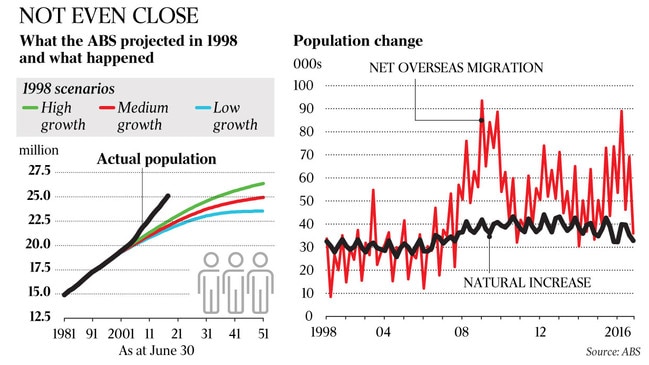Economic boom brings rapid rise in population
Predictions that Australia’s population would not hit 25 million until 2051 were shattered a decade after they were made.
Predictions that Australia’s population would not hit 25 million until 2051 were shattered a decade after they were made, with a booming economy pushing birthrates and migration levels to heights the Australian Bureau of Statistics could not forecast.
An economic boom, helped by the introduction of the now-defunct baby bonus, and the rapid growth in international students and migrants led to the population milestone being reached this week, 33 years earlier than the ABS projected in 1998.
But the ABS said those projections could not have foreseen such dramatic changes at the time, and by 2008 it had updated its assumptions to correctly predict the population to reach 25 million in August this year.
“The assumptions incorporate trends known at the time but cannot include future changes to policies or programs that affect areas such as migration or changes to birth rates after they are made,” an ABS spokesman said.
“The 1998 published projection assumptions did not account for changing migration settings — essentially an increase in skilled migrant, education and permanent visa numbers in the mid-2000s — meaning actual (net overseas migration) departed substantially from assumptions.”

At that time, Australia’s birthrate was 1.77 and falling, net overseas migration was less than 89,000 and life expectancy was at 76.2 years for men and 81.8 for women.
Social researcher Mark McCrindle said the birthrate rose following the introduction of the baby bonus in 2002, and a booming economy that provided a sense of financial security saw it reach almost 2 per woman in 2008, before the global financial crisis took hold. “The assumption back (in 1998) was that it would fall … we’d already fallen below 1.8, and it would probably get to 1.6,” Mr McCrindle said. “I think the strength of the economy over the last 20 years has helped that, and when there’s a strong economy (and) households feel secure they tend to have more children.”
Mr McCrindle said Peter Costello’s call to have “one for mum, one for dad and one for the country” signalled having more children was a good thing to potential parents who had heard years of talk about over-population.
Net migration also rose rapidly, reaching 240,000 in the last 12 months, in line with the rise of China’s middle class, the growth of Australia’s international education industry and the skilled migration program. “None of that could have been foreseen,” Mr McCrindle said.
“There was a simple assumption that gains in life expectancy, would ease off, if not plateau. They thought that if we have very slow increases the life expectancy by the middle of this century would be 82 for men and 86 for females. We’re already at 81 and 85.’’


